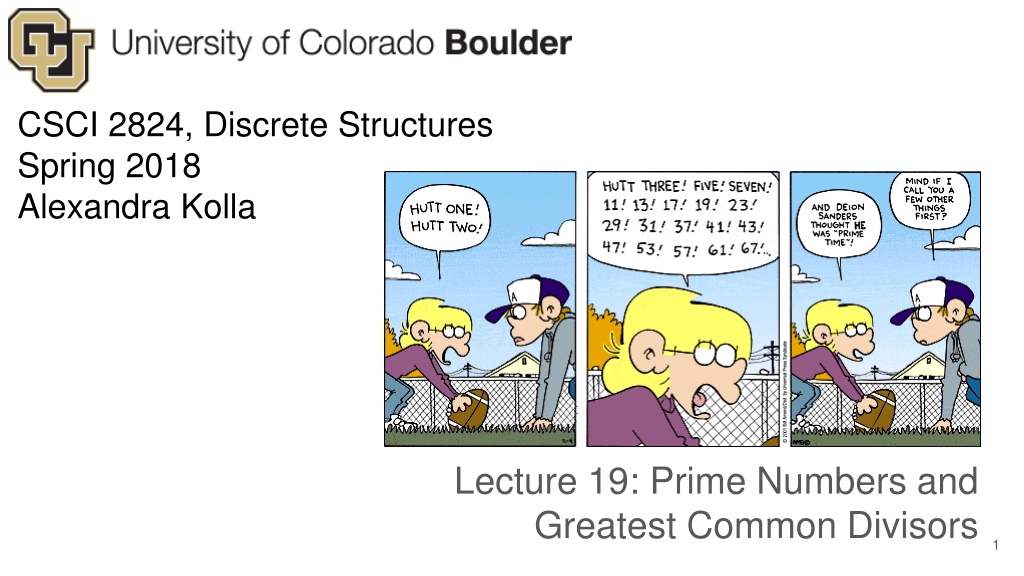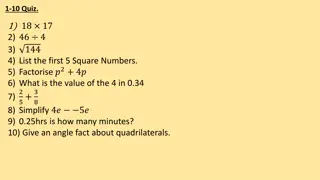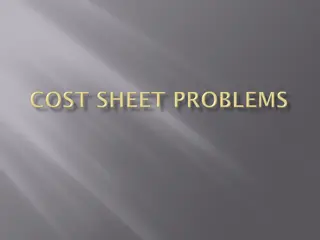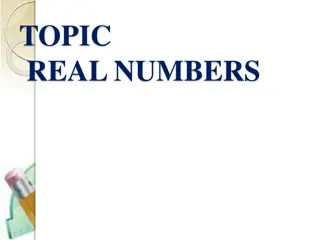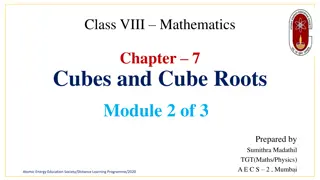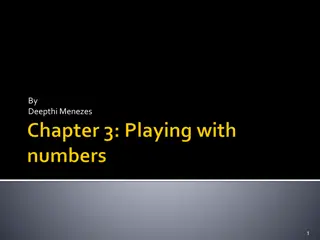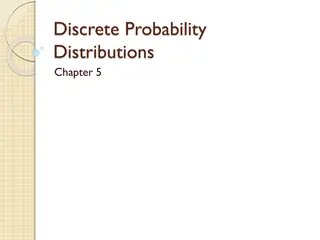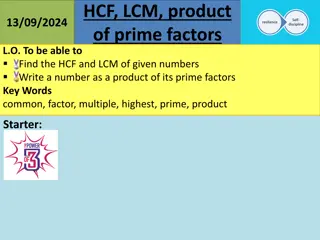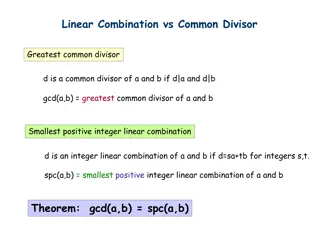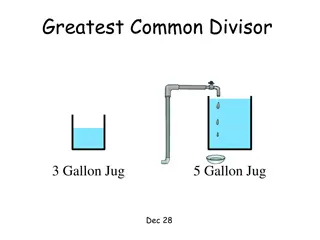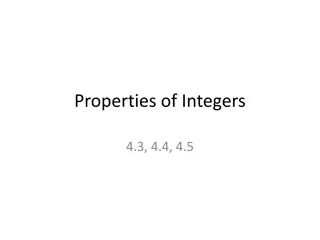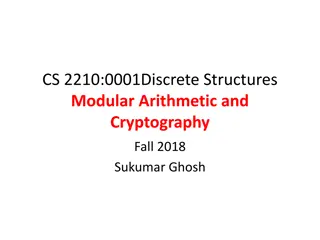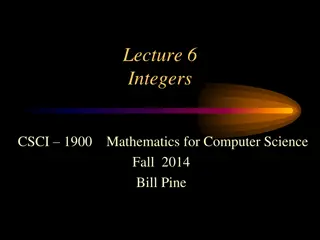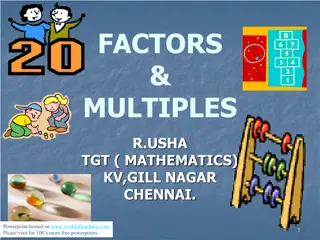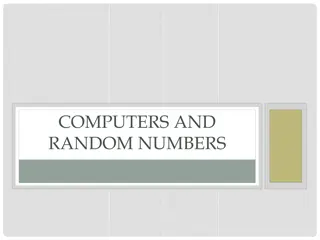Understanding Prime Numbers and Greatest Common Divisors in Discrete Structures
Cryptography relies on prime numbers and the fundamental theorem of arithmetic to ensure security. We explore the concept of prime numbers, composite numbers, and how to test for primality using trial division. The Fundamental Theorem of Arithmetic establishes that every integer can be uniquely factored into prime numbers. The key is to determine the prime factors in order of nondecreasing size. By understanding these principles, we can enhance our ability to work with large numbers efficiently.
Download Presentation

Please find below an Image/Link to download the presentation.
The content on the website is provided AS IS for your information and personal use only. It may not be sold, licensed, or shared on other websites without obtaining consent from the author. Download presentation by click this link. If you encounter any issues during the download, it is possible that the publisher has removed the file from their server.
E N D
Presentation Transcript
CSCI 2824, Discrete Structures Spring 2018 Alexandra Kolla Lecture 19: Prime Numbers and Greatest Common Divisors 1
If you have concerns about how your exam was graded: Check the solutions first. Solutions are available under the Resources tab on Piazza. Put in writing what specifically you want me to look at. Bring this note and your exam to me by Friday 9 March. If you ask me to regrade a question, I will regrade the WHOLE exam. 2
What did we do last time? We learned about binary representations of numbers particularly, large numbers.... and looked at how binary representations and modular arithmetic/exponentiation can help us to calculate things more efficiently! Today: What s the deal with prime numbers? 3
Primes and GCDs Cryptography relies heavily on our ability to find large prime numbers, and our inability to factor large numbers efficiently. Definition: An integer p > 1 is prime if it is only divisible by 1 and itself. Examples: 2, 3, 5, 7, 11, are all prime. Definition: An integer n is composite if there exists an integer a such that a | n and 1 < a < n Examples: 9 is composite because 9 = 3 3 Fun fact: Every composite number can be factored uniquely into a product of prime numbers. 4
Primes and GCDs How about a theorem to solidify our Fun Fact ? A fundamental theorem, at that! The Fundamental Theorem of Arithmetic: Every integer greater than 1 can be written as a prime or as a unique product of two or more primes, where the prime factors are written in order of nondecreasing size Examples: 120 = 2 2 2 3 5 = 23 3 5 144 = 2 2 2 2 3 3 = 24 32 360 = 2 2 2 3 3 5 = 23 32 5 5
Primes and GCDs To test if an integer is prime, we can do trial division To test if n is prime Loop over list of prime numbers piand check if pi| n If pi n for all primes then n is prime Important question: How many primes do we need to check? 6
Primes and GCDs To test if an integer is prime, we can do trial division To test if n is prime Loop over list of prime numbers piand check if pi| n If pi n for all primes then n is prime Important question: How many primes do we need to check? Answer: Only those Why? S pose a composite number n = ab. Then if it must be the case that , so checking the primes is sufficient to find one of these two. 7
Primes and GCDs Example: Check if n = 113 is prime. Solution: Note that , and 112= 121 > 113, so we only need to check primes < 10 113 / 2 = 56.5 113 / 3 36.67 113 / 5 22.6 113 / 7 16.14 Since there are no more primes < 10, we re done, and conclude that n = 113 is prime. 8
Primes and GCDs We can also use TD to compute prime factorization of composite numbers Example: Find the prime factorization of n = 1617 1617 / 2 = 808.5 1617 / 3 = 539 1617 = 3 539 / 2 = 269.5 539 / 3 179.67 539 / 5 = 107.8 539 / 7 = 77 1617 = 3 7 77 / 7 = 11 1617 = 3 7 7 And 11 is prime. 1617 = 3 72 11 9
Primes and GCDs FYOG: For each of the following, use trial division to determine if they are prime. If they are composite, then find their prime factorization. n = 29 n = 97 n = 143 10
Primes and GCDs Note that to do trial division we needed a (potentially long) list of prime numbers. Finding lists of prime numbers is usually done with a sieve A prime sieve works by creating a list of all integers up to a desired limit and progressively removing composite numbers until only primes are left We ll look at the simplest prime sieve: the Sieve of Eratosthenes (~250 BC) Note that more efficient versions exist: Sieve of Sundaram (1934) Sieve of Atkin (2004) Various Wheel Sieves 11
Primes and GCDs Sieve of Eratosthenes - in words Start with complete list of all positive integers up to the desired limit (N) 1 doesn t count Remove all multiples of the lowest prime number, 2 Remove all multiples of the next lowest prime number, 3 Remove all multiples of the next lowest prime number, 5 Remove all multiples of the largest prime number 12
Sieve of Eratosthenes - illustrated Start with complete list of all positive integers up to the desired limit (here, N=100) 1 2 3 4 5 6 7 8 9 10 11 12 13 14 15 16 17 18 19 20 21 22 23 24 25 26 27 28 29 30 31 32 33 34 35 36 37 38 39 40 41 42 43 44 45 46 47 48 49 50 51 52 53 54 55 56 57 58 59 60 61 62 63 64 65 66 67 68 69 70 71 72 73 74 75 76 77 78 79 80 81 82 83 84 85 86 87 88 89 90 91 92 93 94 95 96 97 98 99 100 13
Sieve of Eratosthenes - illustrated 1 doesn t count 1 2 3 4 5 6 7 8 9 10 11 12 13 14 15 16 17 18 19 20 21 22 23 24 25 26 27 28 29 30 31 32 33 34 35 36 37 38 39 40 41 42 43 44 45 46 47 48 49 50 51 52 53 54 55 56 57 58 59 60 61 62 63 64 65 66 67 68 69 70 71 72 73 74 75 76 77 78 79 80 81 82 83 84 85 86 87 88 89 90 91 92 93 94 95 96 97 98 99 100 14
Sieve of Eratosthenes - illustrated Remove all multiples of the lowest prime number, 2 1 3 4 5 6 7 8 9 10 2 11 12 13 14 15 16 17 18 19 20 21 22 23 24 25 26 27 28 29 30 31 32 33 34 35 36 37 38 39 40 41 42 43 44 45 46 47 48 49 50 51 52 53 54 55 56 57 58 59 60 61 62 63 64 65 66 67 68 69 70 71 72 73 74 75 76 77 78 79 80 81 82 83 84 85 86 87 88 89 90 91 92 93 94 95 96 97 98 99 100 15
Sieve of Eratosthenes - illustrated Remove all multiples of the next lowest prime number, 3 1 4 5 6 7 8 9 10 2 3 11 12 13 14 15 16 17 18 19 20 21 22 23 24 25 26 27 28 29 30 31 32 33 34 35 36 37 38 39 40 41 42 43 44 45 46 47 48 49 50 51 52 53 54 55 56 57 58 59 60 61 62 63 64 65 66 67 68 69 70 71 72 73 74 75 76 77 78 79 80 81 82 83 84 85 86 87 88 89 90 91 92 93 94 95 96 97 98 99 100 16
Sieve of Eratosthenes - illustrated Remove all multiples of the next lowest prime number, 5 1 4 6 7 8 9 10 2 3 5 11 12 13 14 15 16 17 18 19 20 21 22 23 24 25 26 27 28 29 30 31 32 33 34 35 36 37 38 39 40 41 42 43 44 45 46 47 48 49 50 51 52 53 54 55 56 57 58 59 60 61 62 63 64 65 66 67 68 69 70 71 72 73 74 75 76 77 78 79 80 81 82 83 84 85 86 87 88 89 90 91 92 93 94 95 96 97 98 99 100 17
Sieve of Eratosthenes - illustrated Remove all multiples of the next lowest prime number, 7 1 4 6 8 9 10 2 3 5 7 11 12 13 14 15 16 17 18 19 20 21 22 23 24 25 26 27 28 29 30 31 32 33 34 35 36 37 38 39 40 41 42 43 44 45 46 47 48 49 50 51 52 53 54 55 56 57 58 59 60 61 62 63 64 65 66 67 68 69 70 71 72 73 74 75 76 77 78 79 80 81 82 83 84 85 86 87 88 89 90 91 92 93 94 95 96 97 98 99 100 18
Sieve of Eratosthenes - illustrated Those are all of the primes , so we re done. The remaining elements in our list are the primes N 1 2 3 4 5 6 8 9 10 7 12 14 15 16 18 20 11 13 17 19 21 22 24 25 26 27 28 30 23 29 32 33 34 35 36 38 39 40 31 37 42 44 45 46 48 49 50 41 43 47 51 52 54 55 56 57 58 60 53 59 62 63 64 65 66 68 69 70 61 67 72 74 75 76 77 78 80 71 73 79 81 82 84 85 86 87 88 90 83 89 91 92 93 94 95 96 98 99 100 97 19
Primes and GCDs Sieve of Eratosthenes - implementation hints Don t need to do cancellation for primes larger than Use a Boolean array instead of integers (the indices store the integers for free!) Initialize elements to True, set to False to cross out The remaining True indices will give the locations of the primes For the bold: Don t need to consider even numbers aside from 2 So can save storage by only tracking the odds 20
Primes and GCDs The largest integer that divides two integers is called their greatest common divisor Definition: Let a and b be nonzero integers. The largest integer d such that d | a and d | b is called the greatest common divisor of a and b and is denoted by gcd(a, b) Example: Find gcd(12, 36) 21
Primes and GCDs The largest integer that divides two integers is called their greatest common divisor Definition: Let a and b be nonzero integers. The largest integer d such that d | a and d | b is called the greatest common divisor of a and b and is denoted by gcd(a, b) Example: Find gcd(12, 36) Solution: The common divisors of 12 and 36 are: 1, 2, 3, 4, 6 and 12 So gcd(12,36) = 12 22
Primes and GCDs Example: Find gcd(48, 360) 23
Primes and GCDs Example: Find gcd(48, 360) Solution: Prime factorizations can make this easier: 48 = 2 2 2 2 3 = 24 3 And 360 = 2 2 2 3 3 5 = 23 32 5 they both share factors of 23and 3, so gcd(48, 360) = 23 3 = 24 24
Primes and GCDs Example: Find gcd(15, 26) 25
Primes and GCDs Example: Find gcd(15, 26) Solution: 15 = 3 5 And 26 = 2 13 they share no common factors as all gcd(15, 26) = 1 Definition: If gcd(a,b) = 1, we say that a and b are relatively prime. 26
Primes and GCDs Back to this example: Example: Find gcd(48, 360) Turns out, finding prime factorizations can be time-consuming. Solution: Prime factorizations can make this easier: More efficient algorithms exist, one of which is the Euclidean algorithm. 48 = 2 2 2 2 3 = 24 3 And 360 = 2 2 2 3 3 5 = 23 32 5 they both share factors of 23and 3, so gcd(48, 360) = 23 3 = 24 27
One of the division rules was: Euclidean algorithm: Find gcd(48, 360) if a | b and a | c, then a | (b + c) 1. Start by dividing the larger number by the smaller. 360 = 48 7 + 24 28
One of the division rules was: Euclidean algorithm: Find gcd(48, 360) if a | b and a | c, then a | (b + c) 1. Start by dividing the larger number by the smaller. 360 = 48 7 + 24 Now any divisor of 360 and 48 must also divide 24 = 360 - 48 7 But similarly, also any divisor of 48 and 24 must also divide 360 = 48 7 + 24 29
One of the division rules was: Euclidean algorithm: Find gcd(48, 360) if a | b and a | c, then a | (b + c) 1. Start by dividing the larger number by the smaller. 360 = 48 7 + 24 Now any divisor of 360 and 48 must also divide 24 = 360 - 48 7 But similarly, also any divisor of 48 and 24 must also divide 360 = 48 7 + 24 Thus, the gcd of 360 and 48 must also be the gcd of 24 and 48 (since they all share divisors) So now we have smaller numbers to find the gcd of, which is easier! 1. Continue by dividing the new larger number by the new smaller number 48 = 24 2 + 0 1. Once you find a 0 remainder, the gcd(original # s) = last nonzero remainder 30
Primes and GCDs There is an important fact underlying the Euclidean algorithm: Theorem: If a can be written as a = bq + r, where a, b, q and r are integers, then gcd(a, b) = gcd(b, r) The Euclidean algorithm uses this string of equivalence until you get down to a zero- remainder, and the gcd is the last nonzero remainder found. Why? Because is the last step, we would say that gcd(a,b) = gcd(b,r), but with r = 0, we know a is a multiple of b, and the gcd of two numbers where one is a multiple of the other is the smaller of the two numbers. (That is, gcd(kb, b) = b (k Z+)) 31
Primes and GCDs Example: Use the Euclidean algorithm to find gcd(1001, 1331) 32
Primes and GCDs Example: Use the Euclidean algorithm to find gcd(1001, 1331) Solution: 1331 = 1001 1 + 330 1001 = 330 3 + 11 330 = 11 30 + 0 The last nonzero remainder is 11, so gcd(1001,1331) = 11 That was a lot of work. Let s make a computer do it! 33
Primes and GCDs Pseudocode: Euclidean algorithm to find gcd(a, b) def euclideanAlg(a, b) x = max(a,b) y = min(a,b) while (y != 0): r = x mod y x = y y = r return (x) 34
Primes and GCDs FYOG: Write real code to implement the Euclidean algorithm. FYOG: Use the Euclidean algorithm (by hand, and using your code) to find gcd(111, 201) gcd(1000, 5040) gcd(11111, 111111) 35
Primes and GCDs It turns out that we can always write the gcd of a and b as sa + tb for some integers s and t Bezout s theorem: If a and b are positive integers, then there exist integers s and t such that gcd(a, b) = sa + tb gcd(6, 14) = 2 Example: And 2 = (-2) 6 + (1) 14 (s = -2 and t = 1) We won t prove this one, but we will give an example that illustrates how you can determine s and t 36
Fond memory: Primes and GCDs 1331 = 1001 1 + 330 Example: Recall that gcd(1001, 1331) = 11. 1001 = 330 3 + 11 330 = 11 30 + 0 Then gcd = 11 37
Fond memory: Primes and GCDs 1331 = 1001 1 + 330 Example: Recall that gcd(1001, 1331) = 11. 1001 = 330 3 + 11 330 = 11 30 + 0 Then gcd = 11 = 1001 - 330 3 = 1001 - (1331 - 1001 1) 3 = 1001 - 3 1331 + 3 1001 = 4 1001 - 3 1331 So gcd(1001, 1331) = 4 1001 + (-3) 1331 38
Primes and GCDs Lemma: If a, b and c are positive integers such that gcd(a, b) = 1 and a | bc, then a | c Proof: 1. S pose a, b and c are positive integers s.t. gcd(a, b) = 1 and a | bc 2. there exist s and t Z such that sa + tb = 1 (Bezout s theorem) 3. sac + tbc = c (mult. both sides by c) 4. Since a | bc and a | sac, we know that a | c (from #3) 39
Primes and GCDs Cool. So why do we care? Remember last time, we said that ac bc mod m does not imply that a b mod m Well, it turns out that in some special cases, you can cancel the c out Theorem: Let a, b and c be integers and let m be a positive integer. If ac bc mod m and gcd(c, m) = 1, then a b mod m Proof: Because ac bc mod m , we know that m | (ac - bc) = c(a - b) But gcd(c, m) = 1, so m c, and we know then that m | (a - b) a b mod m 40
Primes and GCDs Example: lemma does not apply Fact: 14 8 mod 6 We would like to divide by 2 and say 7 4 mod 6 (is this even true?) But gcd(2, 6) = 2 1, so we cannot do the cancellation Example: lemma does apply Fact: 39 18 mod 7 We would like to divide by 3 and say 13 6 mod 7 (is this one true?) And gcd(3, 7) = 1, so we can do the cancellation 41
Primes and GCDs: a recap Sieve of Eratosthenes -- find prime numbers Euclidean Algorithm -- find GCDs Fundamental Theorem of Arithmetic -- can write numbers as product of primes Next time: Numbers that are like other numbers 42
Bonus material! 43
FYOG: hints! 44
